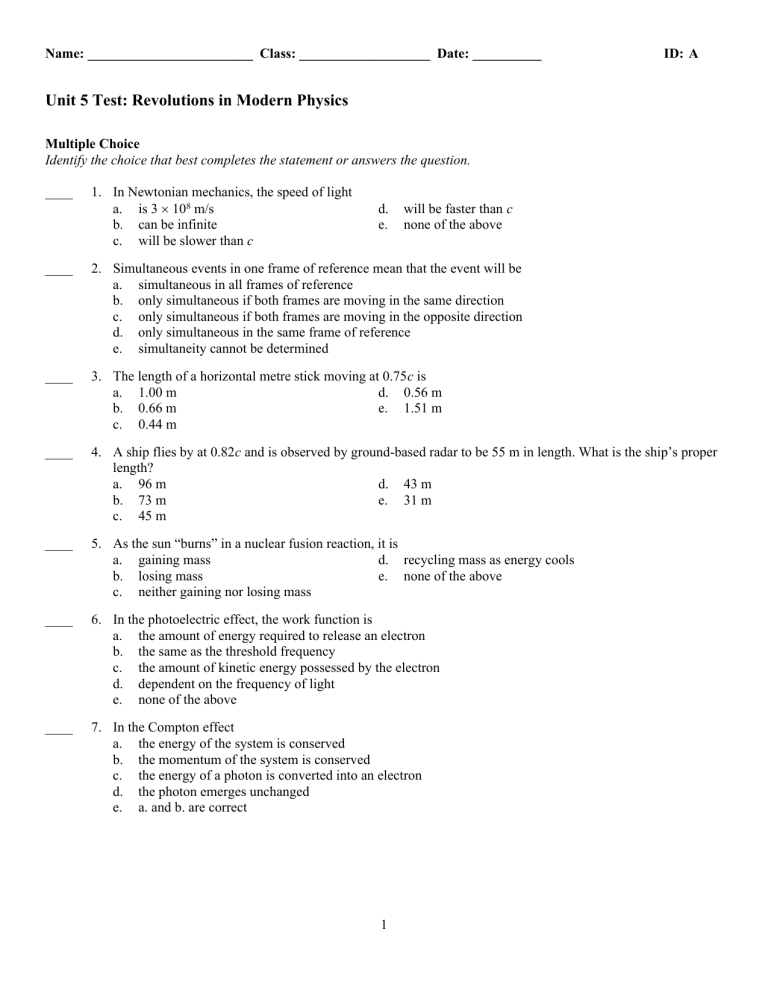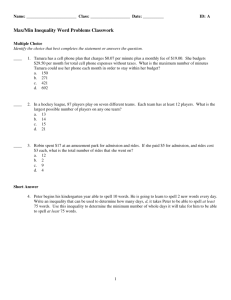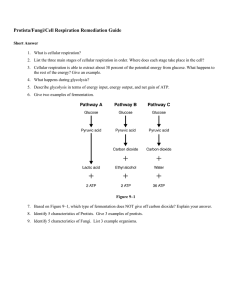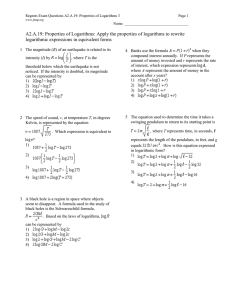
Name: ________________________ Class: ___________________ Date: __________ ID: A Unit 5 Test: Revolutions in Modern Physics Multiple Choice Identify the choice that best completes the statement or answers the question. ____ 1. In Newtonian mechanics, the speed of light a. is 3 108 m/s b. can be infinite c. will be slower than c d. e. will be faster than c none of the above ____ 2. Simultaneous events in one frame of reference mean that the event will be a. simultaneous in all frames of reference b. only simultaneous if both frames are moving in the same direction c. only simultaneous if both frames are moving in the opposite direction d. only simultaneous in the same frame of reference e. simultaneity cannot be determined ____ 3. The length of a horizontal metre stick moving at 0.75c is a. 1.00 m d. 0.56 m b. 0.66 m e. 1.51 m c. 0.44 m ____ 4. A ship flies by at 0.82c and is observed by ground-based radar to be 55 m in length. What is the ship’s proper length? a. 96 m d. 43 m b. 73 m e. 31 m c. 45 m ____ 5. As the sun “burns” in a nuclear fusion reaction, it is a. gaining mass d. recycling mass as energy cools b. losing mass e. none of the above c. neither gaining nor losing mass ____ 6. In the photoelectric effect, the work function is a. the amount of energy required to release an electron b. the same as the threshold frequency c. the amount of kinetic energy possessed by the electron d. dependent on the frequency of light e. none of the above ____ 7. In the Compton effect a. the energy of the system is conserved b. the momentum of the system is conserved c. the energy of a photon is converted into an electron d. the photon emerges unchanged e. a. and b. are correct 1 Name: ________________________ ID: A ____ 8. A 200-g apple falling at 3.0 m/s has a de Broglie wavelength of d. 1.1 1–35 m a. 4.42 10–33 m –35 b. 4.42 10 m e. 9.9 10–36 m –33 c. 1.1 10 m ____ 9. The ionization energy for different elements a. is the same value of energy b. depends on the element c. must be greater than 10.4 eV d. increases as the elements get heavier e. both b. and d. ____ 10. Two spaceships are heading toward each other at a mutual speed of 0.999c. Both ships shine a laser beam at one another. How will each ship see the other light? a. Both ships will see the light travelling at 2c. b. Neither ship will see any light. c. Both ships will see the light travelling at c. d. One ship will see the light travelling at c, and the other will see it travelling at 2c. e. none of the above ____ 11. A scientist in a very fast spaceship wants to do an experiment to determine whether he is moving. Which quantity can be measured to find out whether the scientist is moving or at rest? a. Time can be measured accurately. b. Length can be measured accurately. c. Time and length can be measured together. d. An object can be observed going by the window. e. Nothing can be measured which would indicate this. Short Answer 12. What is meant by the threshold frequency of the photoelectric effect? 13. Why does a wave-particle duality exist for light? 14. Explain the difference between an emission spectrum and an absorption spectrum. 15. What is meant by Heisenberg’s uncertainty principle? 16. A car moving forward at 0.5c turns on its headlights. What would the speed of light appear to be to the driver and to a pedestrian in front of the car? 17. A scanning electron microscope requires the specimen to be coated by a thin layer of a metal, usually gold or platinum. Why is this layer required? 18. A blacksmith is working with iron to make a horseshoe. If the iron had to be at least 3000K before it could be bent, how would the blacksmith know the temperature of the iron simply by looking at it? 2 Name: ________________________ ID: A Problem 19. A subatomic particle with an average lifetime of 2.1 10–9 s at rest is placed into a particle accelerator, and is made to move at 2.6 108 m/s. Calculate the average lifetime of the particle in the accelerator. 20. Superman in saving Earth again, throws a 500-g bomb into space, where it will safely explode. If he throws it with a speed of 0.52c, calculate the bombs relativistic momentum. 21. For an electron with speed 0.880c, calculate its kinetic energy if its total energy is 0.980 MeV. 22. Calculate the frequency required to eject electrons from gold with a work function of 5.47 eV. Essay 23. A car is moving at a rapid pace. It is approaching a garage with doors at either end. The proper length of the car is longer than the length of the garage. As the car travels through the garage, describe what the driver would observe. Describe what would be seen by a stationary observer inside the garage. 24. Describe how a transmission electron microscope and a scanning electron microscope differ in operation. 3 ID: A Unit 5 Test: Revolutions in Modern Physics Answer Section MULTIPLE CHOICE 1. ANS: B PTS: 1 REF: K/U OBJ: 11.1 STA: ME1.05 2. ANS: D PTS: 1 REF: K/U OBJ: 11.1 STA: ME1.01 3. ANS: B PTS: 1 REF: I OBJ: 11.2 STA: ME1.05 4. ANS: A PTS: 1 REF: I OBJ: 11.2 STA: ME2.02 5. ANS: B PTS: 1 REF: MC OBJ: 11.3 STA: ME1.06 6. ANS: A PTS: 1 REF: K/U OBJ: 12.1 STA: ME1.03 7. ANS: E PTS: 1 REF: K/U OBJ: 12.1 STA: ME1.03 8. ANS: C PTS: 1 REF: I | C OBJ: 12.2 STA: ME1.04 9. ANS: B PTS: 1 REF: K/U OBJ: 12.4 STA: ME1.01 10. ANS: C PTS: 1 REF: MC OBJ: 11.2 STA: ME2.02 11. ANS: A Even if the object goes by, it may mean that the ship is at rest or the object is at rest. PTS: 1 REF: MC OBJ: 11.2 STA: ME1.05 SHORT ANSWER 12. ANS: The threshold frequency is the minimum frequency of light (photons) that will eject a photoelectron from a piece of metal. PTS: 2 REF: K/U OBJ: 12.1 STA: ME1.03 13. ANS: Light experiments demonstrate that in certain cases light operates as a wave, and in other cases it behaves like a particle. PTS: 2 REF: K/U OBJ: 12.2 1 STA: ME1.03 ID: A 14. ANS: An emission spectrum produces discrete lines of colour if a gas is excited and the light is detected. An absorption spectrum occurs when white light is passed through the gas, and bands of light are removed from the continuous spectrum as it emerges. PTS: 2 REF: K/U OBJ: 12.4 STA: ME1.04 15. ANS: The uncertainty principle states that an electron’s position and velocity cannot be determined at the same time with any degree of accuracy. PTS: 2 REF: K/U OBJ: 12.6 STA: ME1.04 16. ANS: Both the driver and the pedestrian would see the light moving at c, the speed of light. PTS: 2 REF: MC OBJ: 11.2 STA: ME1.05 17. ANS: The thin layer of metal is designed to prevent a buildup of negative charge due to the electrons. Therefore, the negative charge does not start to repel the incoming beam of electrons. PTS: 2 REF: MC OBJ: 12.2 STA: ME3.02 18. ANS: As the temperature of the iron increases, its colour changes. By knowing the colour that corresponds to the temperature required, the blacksmith would be able to tell the temperature. PTS: 2 REF: MC OBJ: 12.1 STA: ME1.01 PROBLEM 19. ANS: v = 2.6 108 m/s ts = 2.1 10–9 s t s t m v2 1 2 c 2.1 10 9 s 1 (2.6 10 8 m/s) 2 (3.0 10 8 m/s) 2 t m 4.209 10 9 s The average lifetime of the particle is 4.2 10–9 s. PTS: 3 REF: I OBJ: 11.2 2 STA: ME2.02 ID: A 20. ANS: m = 500 g (0.5 kg) v = 0.52c mv p v2 1 2 c (0.5 kg)(0.52)(3 108 m/s) 1 (0.52c) 2 c2 p 9.12 10 7 kg m/s The bomb's relativistic momentum is 9.1 107 kg·m/s. PTS: 3 21. ANS: E total E K E rest REF: I OBJ: 11.2 STA: ME2.02 E K E total mc 2 0.980 MeV (9.11 10 31 kg)(3 10 8 m/s) 2 1.60 10 19 J/eV 0.980 MeV 0.512 MeV E K 0.468 MeV The electron has a kinetic energy of 0.468 MeV. PTS: 3 22. ANS: E K hf W f REF: I OBJ: 11.3 STA: ME1.06 EK W h EK will have to be zero or greater for the electron to be ejected. f (5.47 eV)(1.60 10 19 J/eV) 6.63 10 34 J s f 1.32 10 15 Hz The frequency of light required would be 1.32 1015 Hz. PTS: 3 REF: I | C OBJ: 12.1 3 STA: ME1.03 ID: A ESSAY 23. ANS: As the car is moving through the garage, the driver sees the car as unchanged. The garage will appear to have decreased in length. As the car goes through the garage the driver would see that the car would stick out from both ends of the garage. The stationary observer would see the car as having a decreased length. As the car went through the garage, it would appear that the car would actually fit inside the garage. PTS: 4 REF: C OBJ: 11.2 STA: ME2.06 24. ANS: A transmission electron microscope uses a beam of electrons guided by magnetic lenses to pass through a specimen. More dense regions of the specimen will absorb the electrons. As the electron beam emerges from the other side, it is directed onto a detector (similar to a television) or onto a type of photographic plate. The image produced is a two dimensional view but greatly magnified. A scanning electron microscope also directs a beam of electrons onto the surface of a specimen. The specimen is coated with a thin layer of metal. The electrons are reflected off the surface as they are scanned across the specimen. The reflected electrons are collected, analyzed, and projected onto a monitor. It produces a 3-D image of the surface of the specimen. PTS: 4 REF: C OBJ: 12.2 4 STA: ME3.02



